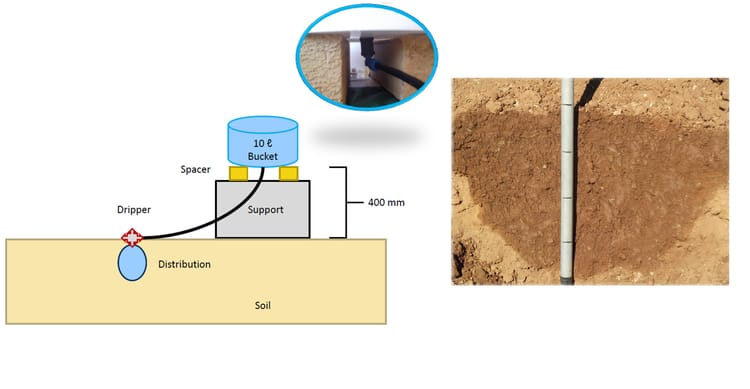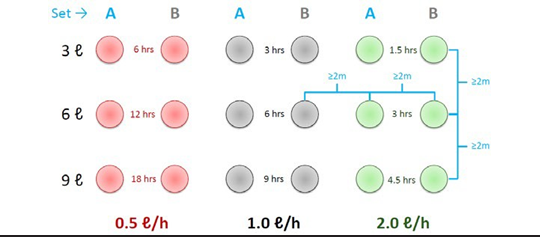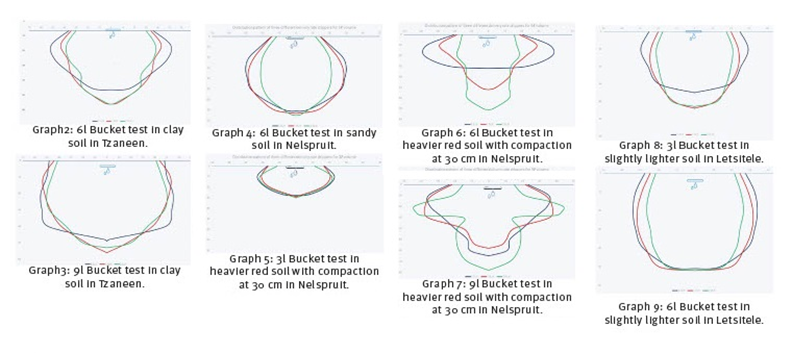Dripper spacing and delivery rate - Understanding water distribution in soil
*This article is a representation of a talk delivered by Jovan Erasmus, agronomist at Netafim South Africa, during the 2022 SABI congress.
In the precision planning process of a drip irrigation system, one of the crucial steps is to determine the correct delivery rate and dripper spacing that will be required for optimal irrigation for your conditions.
To determine the required delivery rate and dripper spacing, we need to understand the way water is distributed in soil. To understand this, we need to ask: what affects water distribution in soil?
Each soil has a unique texture and structure. These physical characteristics of the soil affects soil infiltrability, hydraulic conductivity, water retention and porosity. All of these factors represent important processes that work together holistically to deter- mine movement of water in soil.
Let’s have a basic look at each of these factors.
Infiltrability
Soil infiltrability is the rate at which water can be absorbed into the soil and is mostly determined by soil texture, or the percentage of sand, silt and clay in soil. It is important that the delivery rate of your irrigation system is balanced with the soil’s infiltration rate. If the water is delivered at a rate higher than the rate it is absorbed into the soil, there tends to be greater horizontal spread of water close to the soil surface. This brings risk such as the forming of the shallow root-zone, losing water off the ridges in orchards, ponding, run-off and higher evaporation. In short, water-use efficiency will be negatively affected.
Hydraulic Conductivity
Water moves through soil as it is pulled down by gravity and distributed horizontally by capillary action. Hydraulic conductivity is the water’s potential to move in soil. Water moves on a gradient from wetter soil to dryer soil as illustrated.
The wetter the soil, the easier water will move through it as conductivity is higher. If soil is dryer, the empty pores in the soil must be filled first, and water distribution is slower.
Water Retention
Water retention is the soil’s ability to hold water and nutrients. This greatly depends on the size of the soil particles. Soils with smaller particle sizes offer better water retention. Sandier soils generally have larger particle sizes compared to heavier clay soils, that is why clay soils have better water retention than sandier soils. Better water retention simply means that you can put more water into the soil and that it will hold the water for longer.
Porosity
Soil’s porosity depends on the spaces between soil particles: the macro and micro pores. These are the spaces where water and nutrients are stored and where the roots will grow.
Macro pores allow easy movement of water and air through soil. Water will infiltrate the soil until these pores are filled at which point it reaches saturation and the water will drain past. Soil with larger soil particles have lower porosity and a lower surface to volume ratio. Clay type soils with smaller soil particles have higher porosity with a higher surface to volume ratio. More porous soils allow better water-air balance management in the soil and creates space for the water to move through the soil.
Saturated Circles
When crops are drip irrigated, the water is delivered in one spot, and we rely on the soil’s physical ability to distribute the water. A wetted bulb or saturated circle form under the dripper. Your soil’s physical characteristics and the delivery rate of the dripper will determine the dimensions of this circle.
Remember, roots require oxygen to grow and take up water and nutrients. It is therefore important that there is balance between the water and air that fills soil pores. As water infiltrates soil, it replaces air in the pores. In drip irrigation this creates a gradient between low and high oxygen levels in the soil. Drippers with higher deliver rates displace more air faster, creating variation in the soil’s oxygen levels and leading to lower uptake of water. Drippers with lower delivery rates allow for better hydraulic conductivity without rapidly reducing the levels of oxygen in the root zone. An ideal point of balance between water and oxygen, at which plants will thrive, exists for each soil. When we irrigate, our aim is to manage the root-zone with precision in order to maintain the perfect soil-water balance.
A low infiltrability rate combined with a high flow rate will lead to very wide horizontal distribution, but very shallow vertical distribution. This is often when you see ponding, high run-off and shallow root-zones. By lowering the delivery rate, distribution is more uniform with balanced horizontal and vertical water distribution and a more balanced oxygen level.
Low delivery rates make the necessary balance possible by achieving good infiltration on moist soils. The forces of gravity and capillary action become more equal and soil/ water/air ratios can be kept more constant throughout the wetted area.

Water Distribution Test: For the soil water distribution test, we use a five to ten litre bucket on a platform raised 40cm from the soil surface. Connect a dripper with a chosen flow rate to a thin pipe. Connect the other end of this pipe to the bottom of the bucket and place the dripper end on the soil. Let the bucket run empty. You can now open a profile pit and look at the water distribution pattern.
Case Studies
We conducted experiments on farms in Tzaneen, Letsitele and Nelspruit to test the water distribution patterns for different flow rates in different soils. Always remember that it is extremely important to know the soil you are working with. Without knowledge about how water moves through the soil in question, calculations are futile. This is exactly why experiments like these are valuable. It is very important that these tests are done in very dry soil, otherwise it will be very difficult to see and feel the difference in the soil. We did water distribution tests and dug profile pits to physically measure the wetted area.
The layout below shows the test setup for each soil. Drippers delivering 0.5 ℓ/h,1.0 ℓ/h and 2.0 ℓ/h were tested with 3 ℓ, 6 ℓ and 9 ℓ buckets and appropriate irrigation times.

The best way to appreciate the results is through the graphs below that illustrate the water distribution pattern formed. Note that each colour represents a different dripper delivery rate.

Lessons from the time spent in the field for these experiments:
- Proper soil preparation makes all the difference in achieving balance water distribution and ensuring healthy root zones.
- The lower the flow rate the better the balance between the horizontal and vertical distribution of water.
- Soil compaction will have a massive impact on the distribution of water in your soil. Compaction layers generally occurs at different depths in the soil.
- Water tends to accumulate above compaction layers, thus spreading horizontally above the layer. The top layer of soil will then become saturated which means that there will be little or no oxygen in the soil.
Determining dripper spacing
To determine dripper spacing, there is a lot that must be considered. If you will note width and depth of the water distribution pattern in your soil, you have very good insight into what goes on underneath the soil surface. Knowing this information is important when considering dripper spacing selection and irrigation duration.
When considering these graphs, you will note that the 0,5 ℓ/h dripper had the widest spread and did not wet the soil as deeply as the 1 and 2 ℓ/h drippers. This indicates that with the lower flow you will have better control over your depth of irrigation whilst also maintaining more constant oxygen levels in the soil. You are also less likely to leach fertilizers past your root zone.
The fact remains that water distribution is impacted by many factors and that dripper spacing, dripper delivery rate and irrigation duration must all be selected with care to ensure a health root-zone. There are many decisions that must be made. Understanding soil and water movement and plant requirements makes it a lot easier to make these decisions. Lastly, be sure to involve the necessary experts in the planning process. Remember, a long list of variables must be measured, considered and analysed – do this with the right experts at your side.


Share your thoughts
Comments
We'd love to hear your thoughts! To enter a comment, type your name and email address.